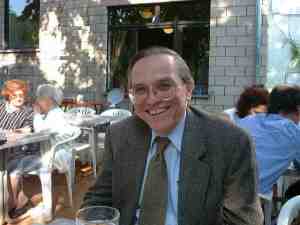 John Florian Sowa is the computer scientist who invented conceptual graphs, a graphic notation for logic and natural language, based on the structures in semantic networks and on the existential graphs of Charles S. Peirce.
John Florian Sowa is the computer scientist who invented conceptual graphs, a graphic notation for logic and natural language, based on the structures in semantic networks and on the existential graphs of Charles S. Peirce.
John F. Sowa said:
“A semantic network or net is a graphic notation for representing knowledge in patterns of interconnected nodes and arcs.”
He is currently developing high-level “ontologies” for artificial intelligence and automated natural language understanding. International conferences on conceptual graphs have been held for over a decade since before 1992. Sowa combines ideas from numerous disciplines and eras modern and ancient, for example, applying ideas from Aristotle, the medieval Scholastics to Alfred North Whitehead and including database schema theory, and incorporating the model of analogy of Islamic scholar Ibn Taymiyyah in his works.
So, this scholar has been working in the connexion between semantic networks and artificial intelligence. In his article about semantic networks however, he also links this term with other knowledge areas:
“ Computer implementations of semantic networks were first developed for artificial intelligence and machine translation, but earlier versions have long been used in philosophy, psychology, and linguistics. “
In his article about Semantic Networks he explains what is common in all semantic networks is:
” A declarative graphic representation that can be used either to represent knowledge or to support automated systems for reasoning about knowledge”
After that he explains six of the most common kinds of semantic networks, each of which is discussed in detail in each of the sections of his article.
These are the 6 main types:
- Definitional networks emphasize the subtype or is-a relation between a concept type and a newly defined subtype. The resulting network, also called a generalization or subsumption hierarchy, supports the rule of inheritancefor copying properties defined for a supertype to all of its subtypes. Since definitions are true by definition, the information in these networks is often assumed to be necessarily true.
- Assertional networks are designed to assert propositions. Unlike definitional networks, the information in an assertional network is assumed to be contingently true, unless it is explicitly marked with a modal operator. Some assertional netwoks have been proposed as models of the conceptual structuresunderlying natural language semantics.
- Implicational networks use implication as the primary relation for connecting nodes. They may be used to represent patterns of beliefs, causality, or inferences.
- Executable networks include some mechanism, such as marker passing or attached procedures, which can perform inferences, pass messages, or search for patterns and associations.
- Learning networks build or extend their representations by acquiring knowledge from examples. The new knowledge may change the old network by adding and deleting nodes and arcs or by modifying numerical values, called weights, associated with the nodes and arcs.
- Hybrid networks combine two or more of the previous techniques, either in a single network or in separate, but closely interacting networks.
References:
- John F. Sowa (1992) “Semantic Networks” Retrieved 26.02.2012 from http://www.jfsowa.com/pubs/semnet.htm
- Atteveldt, W.H. van (25/09/2008) “Semantic Network Analysis : Techniques for Extracting, Representing, and Querying Media Content” Retrieved 21.02.2012 from http://books.google.es/books?id=CURaAAAAYAAJ&q=semantic+network&dq=semantic+network&hl=es&sa=X&ei=7-1DT8boK4WyhAf0y6jXBQ&ved=0CDAQ6AEwAA
- John F. Sowa. (2011, January 10). In Wikipedia, The Free Encyclopedia. Retrieved 22:51, February 26, 2012, from http://en.wikipedia.org/w/index.php?title=John_F._Sowa&oldid=407156835
Sources
- John F. Sowa photo Retrieved 19/03/2012 from http://wdict.net/word/john+f.+sowa
External links (Personal web pages)
- Wouter Van Atteveldt Retrieved 19/03/2012 from http://vanatteveldt.com/index.html
- John F.Sowa Retrieved 19/03/2012 from http://www.jfsowa.com/
Filed under: Humanities, Languages, Logic Tagged: John F.Sowa, Logic, natural lenguage, Ontologies, Semantic Network
![]()